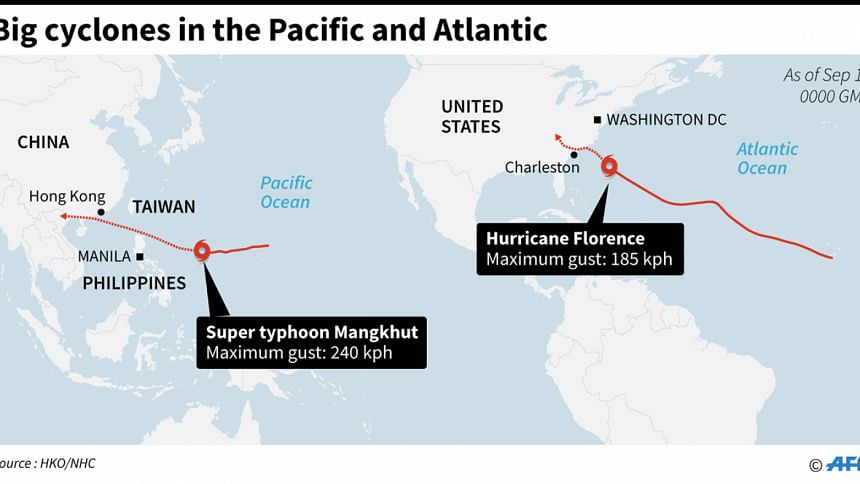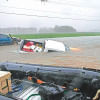Hurricane Florence closes in on US east coast

Hurricane Florence was on course Wednesday to deliver a powerful blow to the east coast of the United States, with forecasters warning of life-threatening rainfall and flooding even as it weakened to a Category 2 storm.
Georgia joined four other coastal states issuing an emergency declaration as forecasts showed Florence dumping historic amounts of torrential rain on the southern state.
As Florence closed in, President Donald Trump and state and local officials urged residents in the path of the storm to evacuate before it was too late.
Appeals to stay safe came from as far away as space as German astronaut Alexander Gerst tweeted pictures of the monster storm taken from the International Space Station along with the warning: "Watch out, America!"
The National Hurricane Center (NHC) said that Florence's maximum sustained winds had eased to 110 miles per hour (175 kph) and it had been downgraded to a Category 2 storm from Category 3 on the five-level Saffir-Simpson wind scale.
It was the second such drop in the space of hours, but the Miami-based NHC stressed it remained "a life-threatening situation" due to the risks of storm surge around coastal areas.
Up to 1.7 million people are under voluntary or mandatory evacuation orders, and coastal residents were frantically boarding up homes and businesses and hitting the road on Wednesday as the storm approached.
"Get out of its way, don't play games with it, it's a big one, maybe as big as they've seen," Trump said. "We'll handle it. We're ready, we're able.
"Protection of life is the absolute highest priority," he added.
'Mike Tyson punch'
Florence is forecast to dump up to 40 inches (one meter) of rain in some areas after it makes landfall in North and South Carolina.
"This rainfall would produce catastrophic flash flooding and significant river flooding," the NHC said.
Life-threatening storm surges of up to 13 feet were also forecast in some areas along with the possibility of tornadoes in North Carolina.
"This is going to be a Mike Tyson punch to the Carolina coast," said Jeff Byard, associate administrator for response and recovery at the Federal Emergency Management Agency.
"This is not going to be a glancing blow," Byard said, warning of power outages, road closures, infrastructure damage and potential loss of life.
Duke Energy, a power company in the Carolinas, estimated that one million to three million customers could lose electricity because of the storm and that it could take weeks to restore.
At 11:00 pm (0300 GMT), the eye of the storm was 280 miles (450 km) southeast of Wilmington, North Carolina, moving northwest at 17 mph.
The storm was heading for the coast of the two states but heavy rain was also expected in Virginia to the north and Georgia to the south.
Georgia Governor Nathan Deal declared a state of emergency "in light of the storm's forecasted southward track after making landfall".
"The state is mobilizing all available resources to ensure public safety," Deal said. "I encourage Georgians to be prepared for the inland effects of the storm as well as the ensuing storm surge in coastal areas."
A state of emergency has also been declared in Maryland, North Carolina, South Carolina, Virginia and Washington.
People fleeing coastal North and South Carolina clogged highways Wednesday as Florence bore down for a direct hit in the low-lying region dense with beachfront vacation homes.
The eastbound lanes of several major highways have been shut to allow traffic to flow inland, but the exodus was slow along roads jammed with outward-bound vehicles.
'You can't stop Mother Nature'
In Wilmington, Solange Iliou Thompson closed down her restaurant, Indochine, because all of her employees had left the city.
"All my staff are gone," Thompson said. "There's nobody left to work.
"But I'm staying," she said. "The building's solid and Buddha will protect us."
"What can you do?" she asked. "You can't stop Mother Nature."
In a trailer park outside Wilmington, Alondra Espinoza was preparing to leave with her two young children.
"Everything is packed," Espinoza said. "I want to get them as far away as possible.
"I've been through hurricanes before but never with kids," she said. "If it wasn't for them, I wouldn't have minded staying here."
South Carolina ordered the mandatory evacuation of one million coastal residents while North Carolina ordered an evacuation of the Outer Banks, barrier islands that are a popular tourist destination.
In Virginia, 245,000 coastal residents were ordered to evacuate.
Florence is being trailed in the Atlantic by two other storms -- Hurricane Helene and Tropical Storm Isaac.
Helene was weakening, however, and posed no danger to land, the NHC said, while Isaac could bring heavy rain to Martinique, Dominica and Guadeloupe.

 For all latest news, follow The Daily Star's Google News channel.
For all latest news, follow The Daily Star's Google News channel. 








Comments